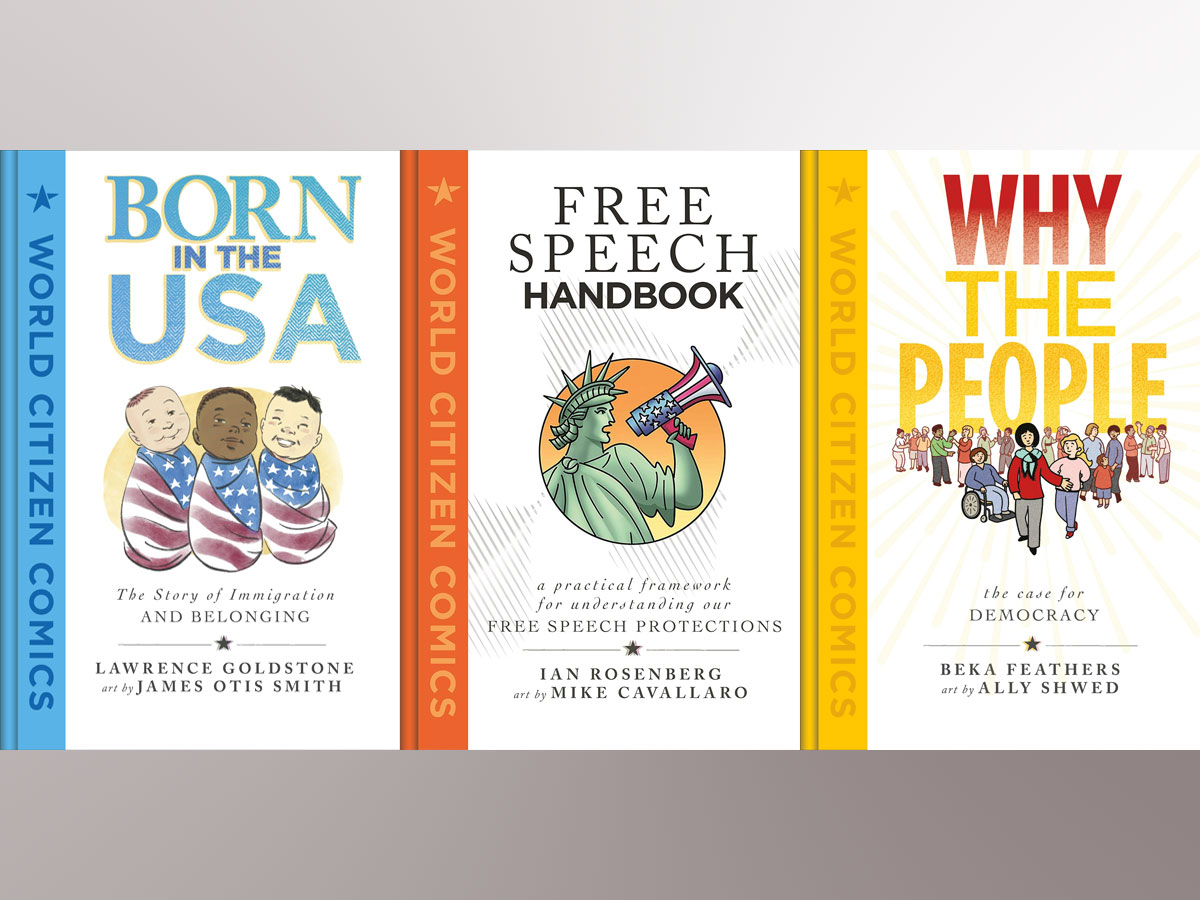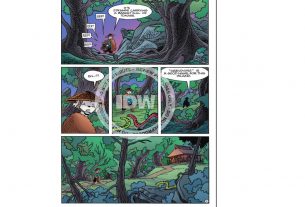First Second, one of my favorite comic book publishers, has a series of books called World Citizen Comics: non-fiction comics meant to educate and inform readers on how to be good citizens. They’ve covered topics like constitutions (both from the US and abroad), elections, patriotism, and disinformation, and they pack a lot of information into a fairly easy to read format. I’ve covered several of them already, and today’s stack is catching up on the last few that I’ve read.
In case you’d like to find out more about the previous titles, here are links to the previous columns where I’ve covered each one:
- Unrig: How to Fix Our Broken Democracy
- Fault Lines in the Constitution
- What Unites Us: Reflections on Patriotism
- RE: Constitutions: Connecting Citizens with the Rules of the Game
- A Firehose of Falsehood: The Story of Disinformation
As I’ve mentioned before, these books are about politics, and of course there are differing opinions about what it means to be a “good citizen,” which means that it’s likely that some readers may find them engaging and enlightening, and others may write them off as biased or too partisan. My own opinion is that if there seems to be a partisan imbalance when discussing something like how disinformation has been used and spread in recent years, it’s because one party has been much more likely to amplify falsehoods. (If fact-checkers seem to be focused on one presidential candidate during the debate, there are two possibilities: one is that the fact-checkers are biased, and the other is that one candidate is making more false claims.)
Born in the USA: The Story of Immigration and Belonging written by Lawrence Goldstone, illustrated by James Otis Smith
Let’s start with this one, which is also the most recent release, because immigration is always a hot button issue, especially during election years. As long as there have been immigrants, there have been people who want to portray immigrants as dangerous and threatening, and controlling who is allowed into the country.
The title of the book is a reference to birthright citizenship, a precedent set in the US in 1898 by the Supreme Court—but one that the current court may yet decide to overturn. This book traces the history of immigration and citizenship in the US and the various ways that it has been restricted, widened, defined, and redefined over the years. From the beginning, there has been a tension between the need for labor—more people—and the drive to control what sort of people those would be. And even when citizenship was offered, what did that mean? Black people earned the right to become citizens much earlier than many Asians, but at the same time were still denied a lot of their civil rights.
Born in the USA spends a lot of its time showing how immigration to the west coast from Asia was a driving factor in many laws that were passed about immigration and citizenship, from the Chinese Exclusion Act to Theodore Roosevelt’s “Gentlemen’s Agreement” that was intended to stem Japanese immigration. It also describes some of the court cases that set precedents about who could become a citizen—since the Constitution offered it to any “free white person,” what was the definition of white? (We learn a bit about the various ways that pseudoscience was used to define “white” futher to benefit specific people while excluding others.)
The book’s framing story involves a young Latina girl: her parents are having a conversation about sweeps in New York for illegal immigrants, and having discussions about what might happen to their kids if they got caught up in them. But they’re safe, right? After all, the kids were born in the US so they’re citizens. From there, the daughter becomes our guide through history, having conversations with founding fathers, senators, judges, mayors, and others who have been involved in the complex and changing system of rules governing citizenship.
I’ll note that the book does include some outdated language that is now seen as offensive, as spoken by various figures throughout history—the author quotes or paraphrases them in part to show the types of arguments they were making at the time. They’re included not to justify or condone the language, but to illustrate the character of these people, but it may still be disconcerting to readers, particularly if you weren’t expecting it.
The book is mostly chronological but does jump around a little here and there, particularly because in many instances there were several different threads that led to particular policies. Some of it I was already familiar with, but the book also provided more context—for instance, the differences in the circumstances of Chinese workers who came during the Gold Rush and the Japanese immigrants (often farmers) who came later. California—San Francisco in particular—plays a big role, with immigrants often being used as a pawn in the struggle between business owners and unions.
Ultimately, this is a story that doesn’t have a conclusive ending yet: even though it seems like the question of birthright citizenship was settled a long time ago, there are those who want to challenge it, and we’ve seen that the Supreme Court is not as beholden to precedent as we once thought. As the book says, unless it is reaffirmed by Congress or the Supreme Court, the citizenship of countless Americans is still up in the air.
For further reading on this subject, I also recommend Open Borders by Bryan Caplan and Zach Weinersmith, which digs into the science and statistics of immigration—we spend so much time and energy trying (and not always succeeding) in controlling exactly who can enter the country, but why? Do any of the reasons to restrict immigration actually pan out? Caplan and Weinersmith dig into that subject.
Free Speech Handbook: A Practical Framework for Understanding our Free Speech Protections written by Ian Rosenberg, illustrated by Mike Cavallaro
Okay, so here’s another term that you’ve probably heard a lot over the past couple of years: free speech. Free speech is our First Amendment right—it’s crucial to our democracy, right? But what does it actually mean? We’ve seen the ways that “free speech” has been used to defend anything from campaign financing by corporations to spreading disinformation on social media.
Free Speech Handbook explains what the law does and doesn’t consider free speech, as told through ten Supreme Court cases, and in each instance the book also brings up some more current examples that illustrate the concepts. Free speech on campuses has been hotly debated recently; Chapter 4 talks about Vietnam War protests and student walkouts to bring attention to gun violence. Elon Musk had a whole lot to say about free speech before and after he purchased Twitter—although this book predates the purchase, Chapter 10 does talk about a case that discussed whether people can be legally restricted from using social media.
From Colin Kaepernick’s kneeling to Westboro Baptist Church’s funeral protests to George Carlin’s “seven dirty words,” the examples covered in Free Speech Handbook are wide-ranging and, well, pretty colorful, and the cases don’t always line up with what you might think seems fair. But the thing about free speech is that sometimes allowing it in one instance that you agree with also means it can be used for something you disagree with—it can be a double-edged sword. I really appreciated this one because it explains a lot of the concepts around free speech with examples that make it easy to grasp.
Why the People: The Case for Democracy written by Beka Feathers, illustrated by Ally Shwed
Julie and Lin are stuck at the airport, just trying to get home for Thanksgiving, when they overhear people around them talking about the government: somebody complains that “we’re turning into a socialist country” and somebody else pipes up that socialism isn’t so bad. One person claims that democracy is the best system of government, and another says that it’s oppressive and imperialistic. This gets Julie and Lin thinking: what are all the different types of systems of government, and how do they work?
As you may expect from the title, this book does argue that democracy is a good system, but first it examines the ways that different governments work, using a few different lenses: Who holds the power? How do they get it? How do they use it? The various combinations of answers to these three questions create different systems, from monarchy to theocracy to dictatorship, and the book gives a lot of real-life examples of these systems. The airport becomes a magical gateway that sends Julie and Lin to various places to talk to the people about what life is like under different leaders and rulers. Instead of just giving a ruling on each one, the author lets Julie and Lin ask a lot of questions and even argue with each other, as they have different backgrounds and differing perspectives on life in America.
As Beka Feathers explains in the author’s note at the end, Why the People isn’t comprehensive—it covers a lot of the major systems, but there are so many forms of government (and flavors of each) that it would be impossible to fit them all into a single volume of this size. Things have necessarily been simplified and omitted, but it does include many of the types that we’re likely to encounter today. It’s a good foundation for understanding how governments work and what they’re for, which also helps us think about when they aren’t doing what they’re supposed to. While no system is perfect, the book encourages readers to work toward governments that serve their people in ways that are fair.
My Current Stack
I just finished reading The Editors by Stephen Harrison, a novel about a Wikipedia-like site and the people who edit it; it was a fascinating story and I’ll tell you more about it soon. I’m hoping to get through a stack of “Art of” movie books that I’ve been putting off—usually I wait until I’ve seen the movie before cracking open the book because I don’t want spoilers, but there are a few here that have been sitting for long enough and my movie-watching is just too far behind, so I’ll probably give in and just read the books first, spoilers or not.
Disclosure: I received review copies of the books in today’s column. Affiliate links to Bookshop.org help support my writing and independent booksellers.







